Selling Art Online for Beginners: A Step-by-Step Starter Guide

Growing your passion for creativity into a profitable one is more attainable now than at any other time thanks to the internet. Whether a painter, illustrator, photographer, or digital artist, the internet offers endless opportunities to reach worldwide audience and build your art business.
If you’re wondering where to start, this guide on selling art online will take you through every necessary step to establish your best foot forward in the art world online.
Why Sell Art Online?
Prior to getting into the details about how to, let’s start with the “why” factors.
- Worldwide: Connect with buyers throughout the world.
- Low Costs: No gallery or store needed.
- Scalable Business: Expand your offerings as you grow.
- Creative Control: Complete ownership of branding and pricing.
Now that you are feeling motivated, let’s go through the process of selling art online the beginner way, in a step-by-step format.
Step 1: Select Your Art Niche
The first step to selling your art online for beginners is to select your niche. A niche aids in building an audience and allows your art to be differentiated from competitors.
Common hobbies in the art niche include;
| Art Niche | Description |
| Abstract Art | Non-representational work that evokes feelings |
| Realism | Lifelike representations in detail |
| Pop Culture Art | Using warm core ideas from movies, TV Shows, or celebrities |
| Digital Illustration | Now large-scale art prints and merchandizing |
| Nature & Landscapes | Texture, decor/space, calming |
Tip: Your niche should reflect your interests and creative strengths.
Step 2: Create a Strong Portfolio
A professional portfolio is basically your digital resume. This provides a place to showcase your best work and adds a level of credibility.
Your portfolio should include:
- High-resolution images of your artwork
- Descriptions that include units of medium, size, and different inspirations
- Pricing and availability
- Testimonials/reviews, or even placeholders for them if you do not have them yet.
A consistent and well-curated portfolio is a good way to build trust for a new seller to start selling online, as well as encourage art sales.
Step 3: Select the Correct Selling Platform
There are multiple platforms that allow artists to display and sell art. Choose one that works well for you and your goals. Are you focused on gaining attention? Do you want to sell your art for commission? Are you most concerned about having your own branded store?
Below are some of the most popular platforms for selling art online:
| Platform | Features |
| ByteDi | Beginner-friendly platform with portfolio and store tools |
Etsy | Great option for handcrafted and customized art |
| Saatchi Art | Curated gallery, sells art to buyers globally |
| Society6 | Best for print-to-order merchandise |
| Redbubble | Easy set-up, enter passive income with easy art prints |
Step 4: Price Your Art Competitively
Pricing can be tricky, especially for new artists. Undervaluing your art can diminish its perceived value, while overpricing may drive potential customers away.
Pricing Formula to Start With:
(Materials + Time x Hourly Rate) + Markup = Final Price
Other considerations:
- Platform fees
- Packaging & shipping costs
- Market demand
When selling art online for beginners, start with a reasonable price and adjust as your reputation grows.
Step 5: Create a Professional Online Presence
Your online presence is not just your store; it also includes your branding, social media accounts, and any other platform your art is on.
These are essential elements:
- A consistent profile picture and artist bio;
- A consistent brand voice and visual identity;
- Clear links to your portfolio and/or store;
- Engaging content showcasing your process.
A unified online presence develops trust and encourages more traffic and conversions, which is essential for beginning artists who sell online.
Step 6: Promote Your Art with Digital Marketing
Simply uploading your work is not enough; you must market your work by promoting it a few times to get potential buyers to the product you are selling.
Marketing Strategies:
- Social Media Marketing: Use Instagram, TikTok and Pinterest to showcase your process and finished work.
- Email Marketing: Set up an email list of potential buyers and once a month give them an update on your work.
- SEO: Use words such as "abstract painting for living room" or "custom pet portrait" in your titles and descriptions for best search visibility.
- Blogging: Start a blog and share your journey, techniques, or art stories to get organic traffic to your site.
In the forum of selling art online for beginners, marketing is essential if you want to get noticed more than others.
Step 7: Know the Shipping and Fulfilment
As you're now selling physical art, you need to focus on packaging, shipping and tracking the shipment. Prepare for that so you can provide a nice experience for your buyers.
Shipping Tips:
- Use quality packing materials to safely cross ship your art
- Provide the buyer tracking numbers
- Include a small note requesting thanks or the business card stub in the package
If this sounds overwhelming, check out print-on-demand services like Pointful and Prettify. They take care of production and shipping for you - especially nice when you’re just beginning to sell art online.
Step 8: Continue to Learn and Grow
Art trends, art platforms, and curation options, and customers' preferences are always evolving. Staying informed is fundamental to your ongoing success.
Ways to Keep Learning:
- Listening to art business podcasts and following art business YouTube channels
- Enrolling in online courses on sites like Skillshare or Coursera
- Connecting with other artists in forums or social media groups
Learning is a constant journey and even more so when selling artwork online for beginners in a rapid digital ecosystem.
Step 9: Monitor Your Performance and Improve
Be sure to monitor what is working and what is not. This may include sales, sources of traffic, customer reviews and marketing endeavours.
Tools such as:
| Tool | Purpose |
| Google Analytics | Understand your site traffic and behaviour |
| Mailchimp | Understand your email campaign |
| Instagram Insights | Understand your engagement and reach |
Monitoring in this manner can provide you with information that will ultimately improve your efforts and increase your outcomes and is useful work in online art selling for beginners.
Additional Tips for Beginners
To wrap up, here are some more tips for new artists starting their art business online:
- Don’t compare your beginning to someone else's middle. Everyone's story is different.
- Spend the money on good photos. When selling art online, the most important thing is the image quality.
- Build an email list as soon as possible. Social media platforms can change their expectations, but your email list is always yours.
- Keep creating. The more art you make, the more chances you have to connect with the right buyers.
Every artist's journey is different. These additional tips for beginners can also help you find success when selling art online!
Mistakes to Avoid
To help you increase your chances of creating a sustainable art business online, steer clear of these mistakes:
- Poor Image Quality: Low-resolution images can be the kiss of death for sales.
- Inconsistent Branding: Confusing for the potential buyer.
- Not Considering SEO: Limits your exposure in search engines.
- Not Researching Your Audience: Results in marketing that doesn't match up.
- Underestimating Shipping Costs: The cost eats into profits.
By being on the lookout for these mistakes, you will save time and money during your online art selling journey as a beginner.
Final Thoughts
For beginners, selling art online may the first send of overwhelming, but with the right strategies, tools, and mindset, you can turn your creative skills into a successful online business. Building a portfolio, marketing, and delivering customer service are all steps toward long-term success.
Keep in mind that it takes time to grow. Take small steps, stay consistent, and keep learning. There are individuals who want to view your art, and we are eager to get it in front of them.
